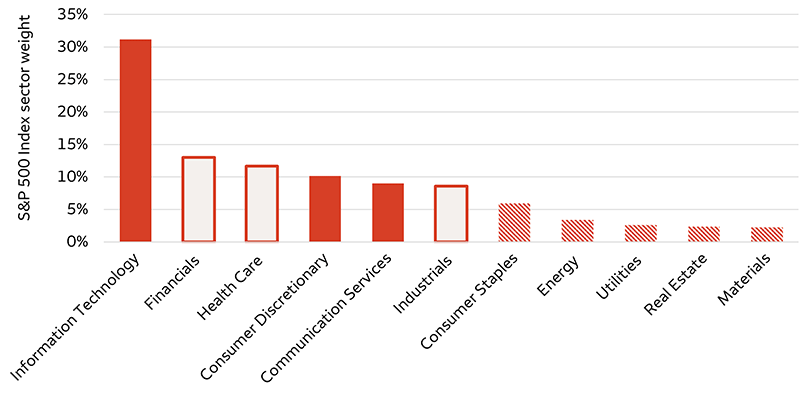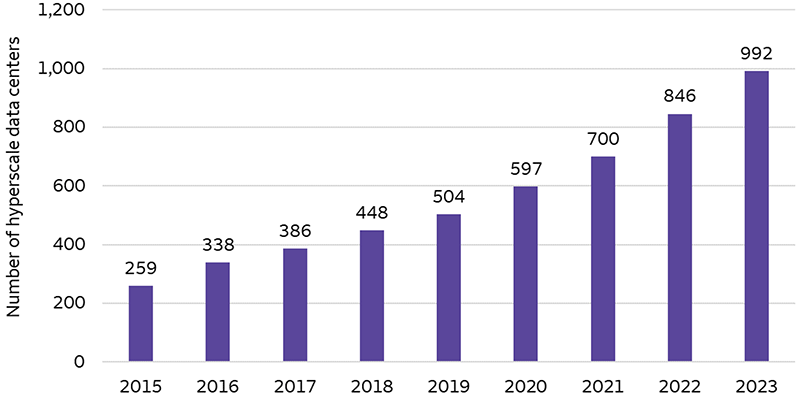Generative AI’s two most visible macroeconomic issues are its potential impact on labor productivity and the job market. Beyond that is the direct, more immediate impact on economic growth from business investment in AI-related technology equipment and software. A McKinsey & Company (McKinsey) study estimated that generative AI could add 0.1% – 0.6% to the global economy’s average annual productivity growth between now and 2040, depending on the speed with which the technology is absorbed and workers’ time savings are realized.1 Increases of that magnitude in the U.S. would imply a material lift to U.S. productivity growth, which fell to 1.5% in the past 10 years from its 2.8% average in the decade before the 2008 – 2009 global financial crisis. A potential boost could also come indirectly from AI’s ability to spur and accelerate innovation, especially as it tends to have the biggest impact on the productivity of cognitive work.
AI’s support to productivity gains is coming at a crucial time — an aging workforce and slowing growth of labor supply are weighing increasingly on economic growth potential for the U.S. and global economies. Stronger productivity growth should help accommodate healthier, noninflationary wage gains and resulting improvements in household living standards.
As with major technology innovations in the past, we expect to see initial labor-market disruptions that will likely vary across occupations. Productivity enhancements should have the greatest impact on data-entry, knowledge-based, and research jobs, particularly in support analyst roles and other professional-service positions.2
We view the U.S. as best positioned to benefit from AI because of its economic size; regulatory stance, which tends to be more flexible and less intrusive; dynamic private and public investment in research and development; and the quality of its higher-education system.3 Importantly, the U.S. appears poised to retain its global technological leadership position not just in terms of AI technology innovation, but also in the way these innovations are disseminated throughout the economy (diffusion) and how quickly they are implemented by businesses and consumers (adaptability).
Improved competitiveness from AI-related productivity enhancements in advanced industries as well as in other industries where the U.S. holds a comparative advantage could support increasingly open trade by tempering the move toward protective industrial policies. Generative AI’s boost to creative potential and productivity in knowledge-based industries could speed the economy’s move up the value-add ladder, better insulating advanced economies from encroachment by lower-cost centers abroad. Ultimately, that could help take some of the edge off criticism of globalization’s cost to employment, exports, and national income.
1 “The economic potential of generative AI: The next productivity frontier,” McKinsey & Company, June 14, 2023.
2 For more on this topic, see the section below titled Labor-market disruptions.
3 “AI, Economies and Markets – How artificial intelligence will transform the global economy,” Capital Economics, 2024.
We believe AI is likely to benefit revenue growth and overall profitability for several technology-focused industries. In addition, AI adoption has the potential to increase productivity and boost profit margins across all sectors. Investors may benefit from not only the global regions, industries, sectors, and companies that are driving the innovation today, but also from those areas with the greatest productivity potential as a result of AI adoption.
Potential AI beneficiaries are the companies at the forefront of developing and adopting these technologies as well as those that are supplying the necessary components. Many of these companies are constituents of the Information Technology, Consumer Discretionary, and Communication Services sectors, which together constitute about half of the S&P 500 Index (Chart 1). We believe exposure to these sectors is appropriate for long-term investors with an interest in AI. Our tactical guidance, which targets a 6 – 18 month timeframe as of this writing, includes a neutral rating on the Information Technology sector, a favorable rating on the Communication Services sector, and an unfavorable rating on the Consumer Discretionary sector. Looking ahead, we may prefer to increase exposures to these sectors if the pace of AI development accelerates, valuations become more attractive, and the risk-reward balance tilts more favorably in our view. However, we also expect that there will be periods when the enthusiasm for AI pushes valuations to levels we find expensive — at these times we may favor reducing exposure, at least temporarily, until more attractive opportunities arise.
Chart 1: S&P 500 Index is heavily weighted toward AI plays 
Sources: Bloomberg, McKinsey, and Wells Fargo Investment Institute. Data as of October 1, 2024. Solid bars indicate the sectors most heavily involved in AI development. Outlined bars indicate the sectors that McKinsey studies indicate may stand to benefit most from AI-fueled productivity improvements. Striped bars indicate the sectors that McKinsey studies indicate may benefit to a lesser degree from AI. An index is not managed and not available for direct investment.
The remaining sectors we view as poised to benefit from AI are those that stand to gain from the implementation of AI products and services rather than the direct development of AI. In other words, second-order beneficiaries. These center mostly around opportunities to improve efficiencies in various areas, to include marketing and sales; customer operations; product development; research and development (R&D); software engineering; supply chain and operations; and risk and legal business processes.
Use cases will likely broaden
Adoption of generative AI has increased substantially in 2024, particularly among professional services industries. While most, if not all, sectors and industries will be noticeably altered by the implementation of generative AI, a few stand out. Regardless, companies across multiple industries continue to seek out expense optimization and improved productivity through the use of AI applications. The McKinsey study estimated that industries within the Health Care, Financials, and Industrials sectors could see the greatest value add through AI implementation.4 For example, AI could deliver improvements for banks and other financial services firms within the Financials sector in product development and marketing, fraud detection, risk management, and customer interactions. Research, drug discovery and development, patient care, treatment, data management, and documentation are all likely to experience step-level improvements with the proper application of AI within the Health Care sector. Meanwhile, AI’s largest potential benefit to companies in the Industrials sector will likely arise from supply-chain optimization, efficient warehousing, factory automation, improvements in marketing processes, software engineering, and R&D. This is not an exhaustive list as the potential applications are impressive.
Table 1: Potential generative AI use cases and capabilities by industry
| Industry |
Use cases and capabilities |
| Automotive and transportation |
Self-driving cars, more efficient car-sales process, connected vehicles, city of the future, ride sharing, and connected vehicles
|
| Health care |
Improved patient data sharing, smart implants, robotic surgeries, more personalized patient management and diagnosis, accelerated drug discovery and development, advanced data analysis, and point-of-service tools for physicians |
| Consumer goods |
Inventory and labor-management efficiencies, improved target marketing, customer service enhancements, supply-chain efficiency, and higher customer engagement |
| Retail and restaurants |
Improved customer demand tracking, inventory optimization, call-center virtual assistants, personalized customer product recommendations, automated service, and upsell products at point of service |
| Advertising, sales, and marketing |
Customized advertising campaigns, content creation (including generation of graphics and images), voice synthesis, customer-facing chat bots, improved ad conversion, increased engagement, and video game development |
| Manufacturing, energy and industrial |
More robotics in manufacturing and distribution, supply-chain optimization, efficient warehousing, internet of things, factory automation, energy usage, pipeline data analysis, and repair and replacement of machinery |
| Financial services |
High-level financial recommendations, faster data access, improved product development, fraud detection, improved risk management, fintech applications for personal finance and lending, and robo-advisors |
| Technology |
Workflow optimization, generation of code, process automation, chat bots for customer support, transcription and summaries of meetings, proofreading, and suggestive correspondence |
| Education |
Enhanced digital-learning capabilities, enhanced critical thinking from students, increased access to information, copyright and plagiarism detection, higher teacher-student engagement, and personalized tutoring |
| Entertainment |
Music generation, video editing, content creation, and video-game interaction |
Sources: Wells Fargo Investment Institute and McKinsey, 2024.
AI-focused data centers
As previously stated, we believe investor attention has been primarily focused on the most visible beneficiaries of the material uptick in investment required to support the development of generative AI — namely certain leading semiconductor firms and a small number of hyperscale cloud service providers (hyperscalers).5 However, the scale of investment taking place and its impact on the broader environment for a wide range of companies remains somewhat underappreciated, in our view. Further, ongoing interest in generative AI should continue to drive spending to build out the infrastructure to support it, namely data centers.
AI-focused data centers typically use more expensive servers that are powered by leading-edge GPU chips for training large language models compared to traditional enterprise servers, which are supported by a central processing unit (CPU) chip. The compute-intensive nature of generative-AI workloads compared to traditional information-technology (IT) workloads is presenting new challenges for overall IT infrastructure, particularly in the form of higher levels of energy consumption. The power-hungry nature of these workloads requires significant amounts of computing, storage, and networking infrastructure. The data-center footprint is expected to expand as more data is captured and utilized in AI-related workloads, and while equipment within the facility is necessary to operate the data center, we see two additional critical needs — reliable power and efficient cooling.
In our view, multiple semiconductor, networking, storage, and hyperscale cloud companies will most likely be the ones helping to create the digital infrastructure necessary to support the modern data center. According to Synergy Research Group, the number of hyperscale data centers increased to 992 exiting 2023 and exceeded the 1,000 level in early 2024. The total number of hyperscale data centers doubled since 2019 (Chart 2). We believe there will continue to be significant data-center capacity brought online over the next few years, driven by the rapid growth of AI applications and sustainable data-center demand. According to research firm Synergy Research Group, hyperscale data-center capacity is expected to triple by the end of 2029, driven by high-compute AI-related applications. That expansion could take the form of new data centers or expanded (or retrofitted) locations to increase capacity and handle the high-intensity workloads that are typical with AI-related functionality.
Chart 2: Number of hyperscale data centers worldwide
Sources: Synergy Research Group, Statista 2024 and Wells Fargo Investment Institute.
4 McKinsey & Company, “The Economic Potential of Generative AI: The Next Productivity Frontier,” June 14, 2023.
5 Hyperscalers refers to hyperscale cloud providers, a small group of companies who operate large networks of large data centers to facilitate cloud computing.





 Sources: Bloomberg, McKinsey, and Wells Fargo Investment Institute. Data as of October 1, 2024. Solid bars indicate the sectors most heavily involved in AI development. Outlined bars indicate the sectors that McKinsey studies indicate may stand to benefit most from AI-fueled productivity improvements. Striped bars indicate the sectors that McKinsey studies indicate may benefit to a lesser degree from AI. An index is not managed and not available for direct investment.
Sources: Bloomberg, McKinsey, and Wells Fargo Investment Institute. Data as of October 1, 2024. Solid bars indicate the sectors most heavily involved in AI development. Outlined bars indicate the sectors that McKinsey studies indicate may stand to benefit most from AI-fueled productivity improvements. Striped bars indicate the sectors that McKinsey studies indicate may benefit to a lesser degree from AI. An index is not managed and not available for direct investment. Sources: Synergy Research Group, Statista 2024 and Wells Fargo Investment Institute.
Sources: Synergy Research Group, Statista 2024 and Wells Fargo Investment Institute.